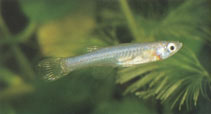| Family: |
Procatopodidae (African lampeyes), subfamily: Procatopodinae |
| Max. size: |
3.5 cm TL (male/unsexed) |
| Environment: |
benthopelagic; freshwater; pH range: 6.5 - 7.19999980926514, non-migratory |
| Distribution: |
Africa: Lake Rukwa (Tanzania) (Ref. 27139, 27292), Malagarazi (Ref. 54847), Wembere system (Ref. 27292) and the Mweru-Luapula area (upper Congo River basin)(Ref. 95585). Also reported from the upper Lualaba (=Upper Congo in Ref. 95585). |
| Diagnosis: |
|
| Biology: |
Prefers surface layer of smaller and more quiet waters which usually are shallow and which may be subject to desiccation from time to time; also found in fast flowing waters; often seen in large accumulations; feeds on small terrestrial insects, water insects and their larvae, and other animals like crustacean and others which they are able to swallow; deposit eggs between plants and roots in shallow water or at margin of waters; young need 8-10 days to hatch (Ref. 27292). Not a seasonal killifish (Ref. 27139). |
| IUCN Red List Status: |
Least Concern (LC); Date assessed: 11 January 2016 Ref. (130435)
|
| Threat to humans: |
harmless |
Source and more info: www.fishbase.org. For personal, classroom, and other internal use only. Not for publication.
